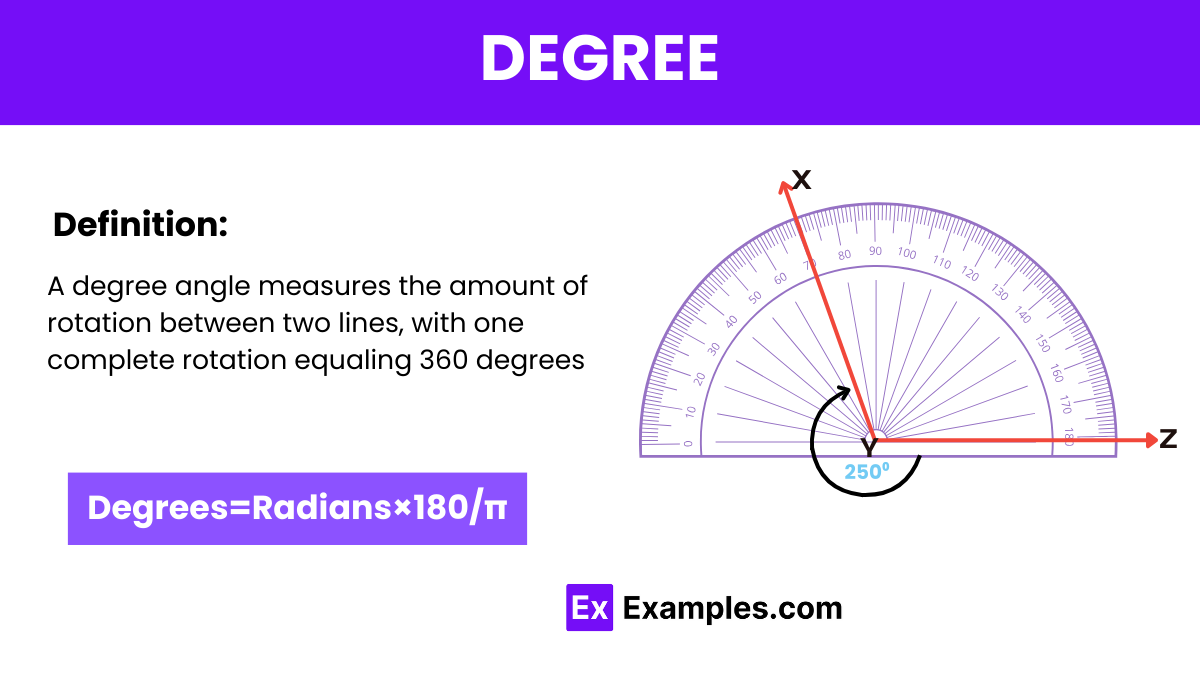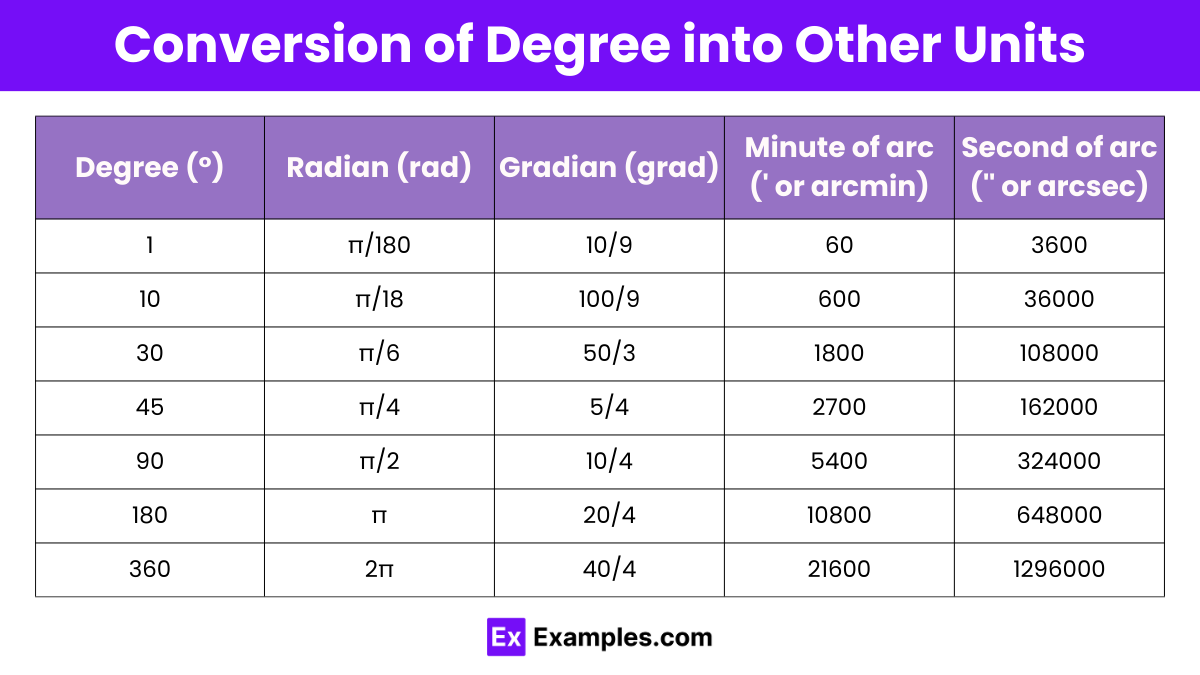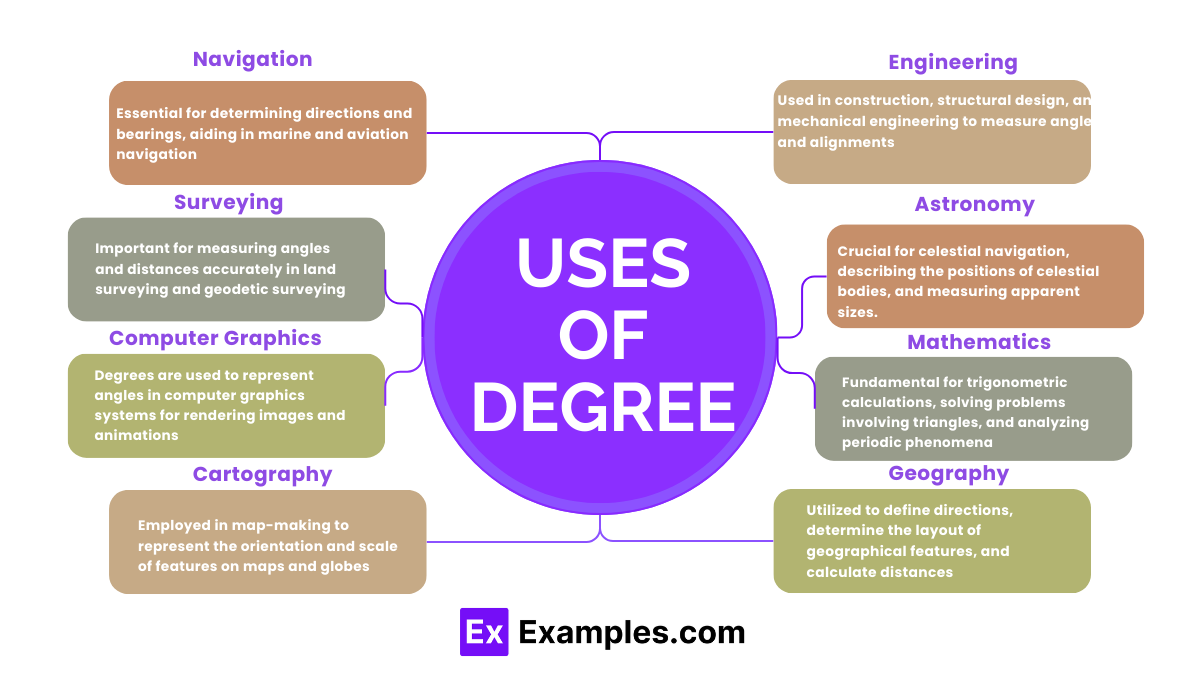What is the degree measure of a right angle?
30 degrees
45 degrees
60 degrees
90 degrees


Degree is a unit of angular measurement equal to 1/360th of a full rotation. It is commonly used to express angles and rotations in various fields such as astronomy, engineering, and geometry.
Arc Length Formula
Sector Area Formula
Tangent of Angle Sum
Cosine of Double Angle
Sine of Double Angle

| Degree (°) | Radian (rad) | Gradian (grad) | Minute of arc (‘ or arcmin) | Second of arc (” or arcsec) |
|---|---|---|---|---|
| 1 | π/180 | 10/9 | 60 | 3600 |
| 10 | π/18 | 100/9 | 600 | 36000 |
| 30 | π/6 | 50/3 | 1800 | 108000 |
| 45 | π/4 | 5/4 | 2700 | 162000 |
| 90 | π/2 | 10/4 | 5400 | 324000 |
| 180 | π | 20/4 | 10800 | 648000 |
| 360 | 2π | 40/4 | 21600 | 1296000 |
One degree (°) is equivalent to π/180 radians (rad). This conversion factor allows for easy interchange between degrees and radians.
One degree (°) equals 10/9 gradians (grad). This conversion factor facilitates the interchange between degrees and gradians in angular measurements.
One degree (°) equals 60 minutes of arc (‘), commonly used in navigation, astronomy, and geographical coordinates for finer angular measurements.
1 Degree (°) equals 3600 seconds of arc (” or arcsec), making it a fundamental unit for measuring angles in trigonometry and astronomy.

Degrees of angles can be found using a protractor, which is a tool designed for measuring angles. Place the center of the protractor at the vertex of the angle, align the base line of the protractor with one side of the angle, and then read the degree measurement where the other side intersects with the protractor scale.
The degree measure of an angle represents the amount of rotation between its two sides, usually measured in degrees. It indicates how much one side must be rotated about the vertex to coincide with the other side. This measure typically ranges from 0 to 360 degrees, with specific categories for different ranges of measure, as mentioned in the first point.
Text prompt
Add Tone
10 Examples of Public speaking
20 Examples of Gas lighting
What is the degree measure of a right angle?
30 degrees
45 degrees
60 degrees
90 degrees
How many degrees are in a full circle?
180 degrees
270 degrees
360 degrees
540 degrees
What is the degree measure of an angle that is supplementary to a 75-degree angle?
105 degrees
115 degrees
75 degrees
45 degrees
How many degrees are in an equilateral triangle?
90 degrees
120 degrees
180 degrees
360 degrees
What is the measure of each angle in an equilateral triangle?
30 degrees
45 degrees
60 degrees
90 degrees
If an angle measures 130 degrees, what is its complement?
50 degrees
40 degrees
60 degrees
Complement does not exist
What is the degree measure of each interior angle of a regular pentagon?
90 degrees
108 degrees
120 degree
135 degrees
How many degrees are in the sum of the interior angles of a hexagon?
540 degrees
720 degrees
900 degrees
1080 degrees
What is the degree measure of each exterior angle of a regular octagon?
30 degrees
45 degrees
60 degrees
90 degrees
What is the degree measure of an angle that is the supplement of a 120-degree angle?
30 degrees
45 degrees
60 degrees
90 degrees
Before you leave, take our quick quiz to enhance your learning!

